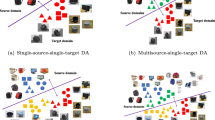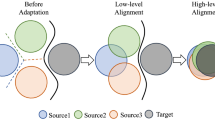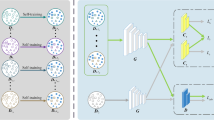Abstract
As an emerging research topic in the field of machine learning, unsupervised domain adaptation (UDA) aims to transfer prior knowledge from the source domain to help training the unsupervised target domain model. Although a variety of UDA works have been proposed, they mainly concentrate on scenarios from one source to one target (1S1T) or multi-source to one target domain (mS1T), the works on UDA from one source to multi-target (1SmT) is rare and they are mainly designed for ordinary problems. When countered with ordinal 1SmT tasks where there exists order relationship among the data labels, the existing methods degenerate in performance since the label relationships are not preserved. In this article, we propose an ordinal 1SmT UDA model which transfers both explicit and implicit knowledge from the supervised source and unsupervised target domains respectively via distribution alignment and dictionary transmission. We also design an efficient algorithm to solve the model and evaluate its convergence and complexity. Finally, the effectiveness of the proposed method is evaluated with extensive experiments.







Similar content being viewed by others
Explore related subjects
Discover the latest articles, news and stories from top researchers in related subjects.References
Zhao M, Zhan C, Wu Z, Tang P (2015) Semi-supervised image classification based on local and global regression. IEEE Signal Process Lett 22(10):1666–1670
Zhao MB, Chow TWS, Peng T, Wang Z, Zukerman M (2016) Route selection for cabling considering cost minimization and earthquake survivability via a semi-supervised probabilistic model. IEEE Trans Industr Inf 13(2):1–1
Gong B, Shi Y, Sha F, Grauman K (2012) Geodesic flow kernel for unsupervised domain adaptation. In: 2012 IEEE conference on computer vision and pattern recognition, pp. 2066–2073
Zhuang F, Luo P, Du C, He Q, Shi Z, Xiong H (2013) Triplex transfer learning: exploiting both shared and distinct concepts for text classification. IEEE Trans Cybern 44(7):1191–1203
Long M, Zhu H, Wang J, Jordan MI (2016) Unsupervised domain adaptation with residual transfer networks. In: Proceedings of the 30th international conference on neural information processing systems, pp. 136–144
Tahmoresnezhad J, Hashemi S (2016) Visual domain adaptation via transfer feature learning. Knowl Inf Syst 50(2):1–21
Zhang L, Zhang D (2016) Robust visual knowledge transfer via extreme learning machine-based domain adaptation. IEEE Trans Image Process 25(10):4959–4973
Liu J, Zhang L (2019) Optimal projection guided transfer hashing for image retrieval. In: Proceedings of the AAAI conference on artificial intelligence, vol. 33, pp. 8754–8761
Liang J, Hu D, Feng J (2020) Do we really need to access the source data? Source hypothesis transfer for unsupervised domain adaptation. In: International conference on machine learning, pp. 6028–6039
Tian Q, Sun H, Ma C, Cao M, Chu Y, Chen S (2021) Heterogeneous domain adaptation with structure and classification space alignment. IEEE Trans Cybern. https://doi.org/10.1109/TCYB.2021.3070545
Pan SJ, Yang Q (2009) A survey on transfer learning. IEEE Trans Knowl Data Eng 22(10):1345–1359
Cortes C, Mohri M, Riley M, Rostamizadeh A (2008) Sample selection bias correction theory. In: International conference on algorithmic learning theory, pp. 38–53
Yao Y, Doretto G (2010) Boosting for transfer learning with multiple sources. In: 2010 IEEE computer society conference on computer vision and pattern recognition, pp. 1855–1862
Tan B, Song Y, Zhong E, Yang Q (2015) Transitive transfer learning. In: Proceedings of the 21th ACM SIGKDD international conference on knowledge discovery and data mining, pp. 1155–1164
Khan MNA, Heisterkamp DR (2016) Adapting instance weights for unsupervised domain adaptation using quadratic mutual information and subspace learning. In: 2016 23rd international conference on pattern recognition (ICPR), pp. 1560–1565
Tan B, Zhang Y, Pan SJ, Yang Q (2017) Distant domain transfer learning. In: Thirty-first AAAI conference on artificial intelligence, pp. 2604–2610
Long M, Wang J, Sun J, Philip SY (2014) Domain invariant transfer kernel learning. IEEE Trans Knowl Data Eng 27(6):1519–1532
Tian Q, Chen S (2017) Cross-heterogeneous-database age estimation through correlation representation learning. Neurocomputing 238:286–295
Li J, Lu K, Huang Z, Zhu L, Shen H (2019) Heterogeneous domain adaptation through progressive alignment. IEEE Trans Neural Netw Learn Syst 30(5):1381
Zhang L, Wang S, Huang G-B, Zuo W, Yang J, Zhang D (2019) Manifold criterion guided transfer learning via intermediate domain generation. IEEE Trans Neural Netw Learn Syst 30(12):3759–3773
Tian L, Tang Y, Hu L, Ren Z, Zhang W (2020) Domain adaptation by class centroid matching and local manifold self-learning. IEEE Trans Image Process 29:9703–9718
Wang W, Chen S, Xiang Y, Sun J, Li H, Wang Z, Sun F, Ding Z, Li B (2021) Sparsely-labeled source assisted domain adaptation. Pattern Recogn 112:107803
Zhao Z, Chen Y, Liu J, Liu M (2010) Cross-mobile elm based activity recognition. Int J Eng Ind 1(1):30–38
Zhao Z, Chen Y, Liu J, Shen Z, Liu M (2011) Cross-people mobile-phone based activity recognition. In: Twenty-second international joint conference on artificial intelligence, pp. 2545–2550
Sun S, Xu Z, Yang M (2013) Transfer learning with part-based ensembles. In: International workshop on multiple classifier systems, pp. 271–282
Wei Y, Zhu Y, Leung CW-k, Song Y, Yang Q (2016) Instilling social to physical: co-regularized heterogeneous transfer learning. In: Thirtieth AAAI conference on artificial intelligence, pp. 1338–1344
Yu H, Chen S (2019) Whole unsupervised domain adaptation using sparse representation of parameter dictionary. J Front Comput Sci Technol 13(05):822–833
Sugiyama M, Nakajima S, Kashima H, Buenau P, Kawanabe M (2007) Direct importance estimation with model selection and its application to covariate shift adaptation. In: NIPS'07: Proceedings of the 20th international conference on neural information processing systems, pp 1433–1440
Long M, Cao Y, Wang J, Jordan M (2015) Learning transferable features with deep adaptation networks. In: International conference on machine learning, pp. 97–105. PMLR
Pan SJ, Tsang IW, Kwok JT, Yang Q (2010) Domain adaptation via transfer component analysis. IEEE Trans Neural Netw 22(2):199–210
Sun B, Feng J, Saenko K (2016) Return of frustratingly easy domain adaptation. In: Proceedings of the AAAI conference on artificial intelligence, vol. 30
Zellinger W, Grubinger T, Lughofer E, Natschläger T, Saminger-Platz S (2017) Central moment discrepancy (cmd) for domain-invariant representation learning. arXiv preprint arXiv:1702.08811
Mancini M, Porzi L, Bulo SR, Caputo B, Ricci E (2018) Boosting domain adaptation by discovering latent domains. In: Proceedings of the IEEE conference on computer vision and pattern recognition, pp. 3771–3780
Caseiro R, Henriques JF, Martins P, Batista J (2015) Beyond the shortest path: Unsupervised domain adaptation by sampling subspaces along the spline flow. In: Proceedings of the IEEE conference on computer vision and pattern recognition, pp. 3846–3854
Peng P, Xiang T, Wang Y, Pontil M, Gong S, Huang T, Tian Y (2016) Unsupervised cross-dataset transfer learning for person re-identification. In: Proceedings of the IEEE conference on computer vision and pattern recognition, pp. 1306–1315
Zhao H, Zhang S, Wu G, Moura JM, Costeira JP, Gordon GJ (2018) Adversarial multiple source domain adaptation. Adv Neural Inf Process Syst 31
Dai Y, Liu J, Ren X, Xu Z (2020) Adversarial training based multi-source unsupervised domain adaptation for sentiment analysis. In: Proceedings of the AAAI conference on artificial intelligence, vol. 34, pp. 7618–7625
Yang L, Balaji Y, Lim S-N, Shrivastava A (2020) Curriculum manager for source selection in multi-source domain adaptation. In: European conference on computer vision. Springer, New York, pp. 608–624
Guo H, Pasunuru R, Bansal M (2020) Multi-source domain adaptation for text classification via distancenet-bandits. In: Proceedings of the AAAI conference on artificial intelligence, vol. 34, pp. 7830–7838
Wang H, Xu M, Ni B, Zhang W (2020) Learning to combine: knowledge aggregation for multi-source domain adaptation. In: European conference on computer vision. Springer, New York, pp. 727–744
Sun B-Y, Li J, Wu DD, Zhang X-M, Li W-B (2009) Kernel discriminant learning for ordinal regression. IEEE Trans Knowl Data Eng 22(6):906–910
Sun B-Y, Wang H-L, Li W-B, Wang H-J, Li J, Du Z-Q (2015) Constructing and combining orthogonal projection vectors for ordinal regression. Neural Process Lett 41(1):139–155
Pan SJ, Tsang IW, Kwok JT, Yang Q (2010) Domain adaptation via transfer component analysis. IEEE Trans Neural Netw 22(2):199–210
Wang J, Feng W, Chen Y, Yu H, Huang M, Yu PS (2018) Visual domain adaptation with manifold embedded distribution alignment. In: Proceedings of the 26th ACM international conference on multimedia, pp. 402–410
Ben-David S, Blitzer J, Crammer K, Pereira F (2007) Analysis of representations for domain adaptation. In: Advances in neural information processing systems, pp. 137–144
Nie F, Huang H, Cai X, Ding CH (2010) Efficient and robust feature selection via joint l2,1-norms minimization. In: Advances in neural information processing systems, pp. 1813–1821
De Campos TE, Babu BR, Varma M et al (2009) Character recognition in natural images. VISAPP 2(7):273–280
Moschoglou S, Papaioannou A, Sagonas C, Deng J, Kotsia I, Zafeiriou S (2017) Agedb: the first manually collected, in-the-wild age database. In: Proceedings of the IEEE conference on computer vision and pattern recognition workshops, pp. 51–59
Ricanek K, Tesafaye T (2006) Morph: A longitudinal image database of normal adult age-progression. In: 7th international conference on automatic face and gesture recognition (FGR06), pp. 341–345
Chen B-C, Chen C-S, Hsu WH (2014) Cross-age reference coding for age-invariant face recognition and retrieval. In: European conference on computer vision, pp. 768–783
Dai W, Yang Q, Xue G-R, Yu Y (2008) Self-taught clustering. In: Proceedings of the 25th international conference on machine learning, pp. 200–207
Jiang W, Chung F-l (2012) Transfer spectral clustering. In: Joint European conference on machine learning and knowledge discovery in databases, pp. 789–803
Deng Z, Jiang Y, Chung F-L, Ishibuchi H, Choi K-S, Wang S (2015) Transfer prototype-based fuzzy clustering. IEEE Trans Fuzzy Syst 24(5):1210–1232
Demisar J, Schuurmans D (2006) Statistical comparisons of classifiers over multiple data sets. J Mach Learn Res 7(1):1–30
Zhao M, Zhang Y, Zhang Z, Liu J, Kong W (2019) Alg: adaptive low-rank graph regularization for scalable semi-supervised and unsupervised learning. Neurocomputing 370:16–27
Acknowledgements
This work was supported by the National Natural Science Foundation of China under Grant 62176128, the Open Projects Program of State Key Laboratory for Novel Software Technology of Nanjing University under Grant KFKT2022B06, the Fundamental Research Funds for the Central Universities No. NJ2022028, the Project Funded by the Priority Academic Program Development of Jiangsu Higher Education Institutions (PAPD) fund, as well as the Qing Lan Project.
Author information
Authors and Affiliations
Corresponding author
Additional information
Publisher's Note
Springer Nature remains neutral with regard to jurisdictional claims in published maps and institutional affiliations.
Rights and permissions
Springer Nature or its licensor holds exclusive rights to this article under a publishing agreement with the author(s) or other rightsholder(s); author self-archiving of the accepted manuscript version of this article is solely governed by the terms of such publishing agreement and applicable law.
About this article
Cite this article
Tian, Q., Sun, H., Chu, Y. et al. Ordinal unsupervised multi-target domain adaptation with implicit and explicit knowledge exploitation. Int. J. Mach. Learn. & Cyber. 13, 3807–3820 (2022). https://doi.org/10.1007/s13042-022-01626-3
Received:
Accepted:
Published:
Issue Date:
DOI: https://doi.org/10.1007/s13042-022-01626-3




